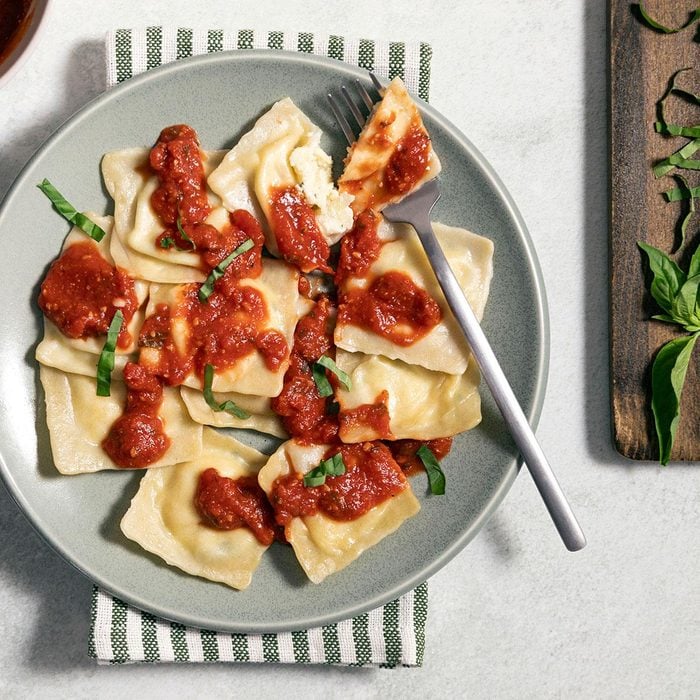One of the most exciting things about homemade ravioli is its versatility. Once you’re familiar with the basics, ravioli recipes are endless! You can add herbs and spices to your dough, mix and match meat and vegetarian fillings, and make myriad pasta sauce recipes and pesto as the seasons change. Plus, if you enjoy the aesthetic side of cooking, homemade ravioli is an excellent canvas for artistry.
Our guide will teach you how to make classic, ricotta-filled ravioli with sugo-style tomato sauce from scratch. After that, you can take what you’ve learned, and make it your own. A couple of optional specialized tools will make the job easier if you elect to use them. A pasta maker is incredibly helpful in rolling out the dough to even thickness. A ravioli cutter is nice, but definitely not required.
Ingredients for Homemade Ravioli
- Flour: No fancy flour required! We make this ravioli with plain old all-purpose flour.
- Eggs: I love the look of pasta dough made with farm-fresh eggs because it takes on the beautiful yellow tint from the yolks. However, pretty much any egg will do. Just make sure to use large eggs, or you’ll have to adjust the recipe accordingly.
- Olive oil: This is a time to splurge on extra virgin olive oil. It will impart good flavor to your dough and your sauce.
- Tomatoes: Look for Italian brands of canned tomatoes like San Marzano tomatoes, or try a premium American brand such as Muir Glen. Crushed tomatoes have a little texture, and combining them with thinner puree and concentrated paste will give your sauce all the tomato punch it needs.
- Parmesan: If you can get it, go big and buy real Italian Parmigiano-Reggiano that you’ll grate yourself. The aged cheese has gorgeous nutty and savory flavor, and will level up any dish in which you use it. If you can’t find it, try using other Parmesan, or Asiago or Pecorino, instead.
- Herbs: Fresh herbs such as basil, oregano and parsley give tomato sauce depth and character. I like to add some to the sauce while it’s cooking, and a little bit more at the end for freshness. If flat-leaf parsley is available, choose that over curly parsley. If you can’t find fresh herbs in stores near you, use our fresh to dried herb conversion to use dried instead.
- Ricotta: Made from leftover whey, ricotta is a mild-tasting, fine-grained cheese that is a perfect base for pasta fillings.
- Mozzarella: This recipe calls for part-skim mozzarella, which has less moisture than fresh mozzarella and is great as a melting cheese. Buy mozz in block form or pre-shredded, depending on your preference.
- Seasonings: The filling lets the fresh herbs shine, calling for just a smidgen of salt and pepper, plus a hint of garlic powder. As with every recipe, taste as you, go and adjust to your liking! Have fresh garlic? You can swap that in for the powder.
Directions
Step 1: Make the dough
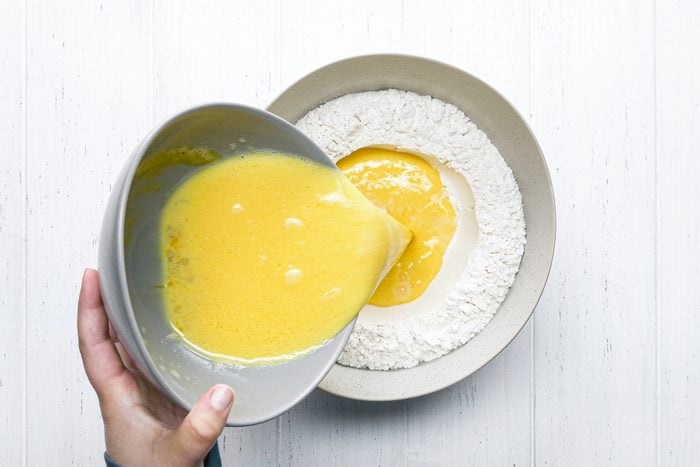
Measure 5 cups flour into a large mixing bowl, and make a well in the center. In a smaller bowl, lightly beat the eggs with water and olive oil. Pour the wet ingredients into the flour well. Using a fork, pull the dry ingredients into the wet ingredients, and stir, continuing until you have a cohesive ball of dough. You can switch to using your hands at any point, if desired.
Editor’s Tip: Flour has a lower water content when humidity is low. If it’s a dry time of year, you may need to add more liquid (egg, water or oil, your choice) to make your pasta dough come together. Conversely, if it’s very humid, you may not need as much water.
Step 2: Knead the dough
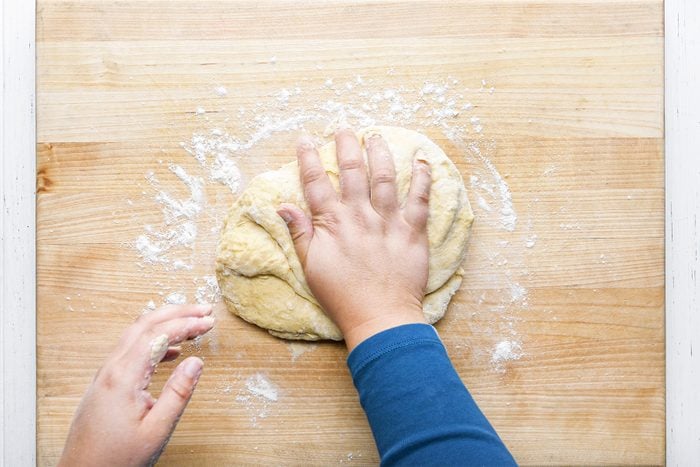
Turn your dough out onto a lightly floured surface, and knead until the dough is smooth, silky and elastic, meaning it bounces back when you press on it, about four to six minutes. Cover the dough, and let rest for 30 minutes.
Editor’s Tip: Depending on how vigorously you knead, this may take as few as four minutes or significantly longer. It’s more about the feel of the dough than the time it takes to get there.
Step 3: Make the tomato sauce
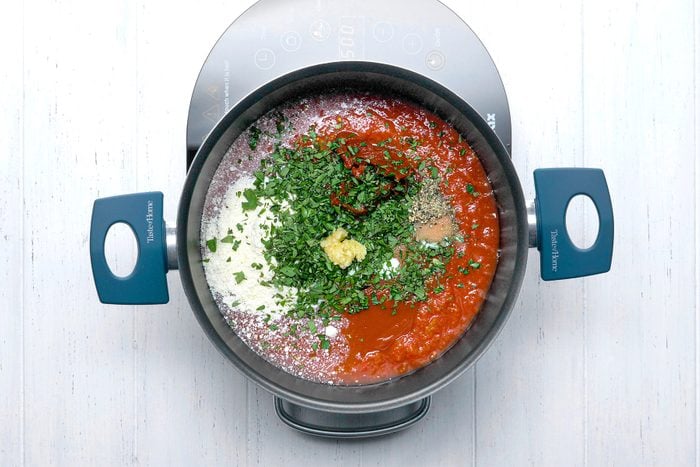
Meanwhile, in a Dutch oven, combine the crushed tomatoes, tomato puree, Parmesan, water, tomato paste, sugar, fresh herbs, garlic, salt and pepper. Bring to a boil, then reduce to a simmer. Cook, covered, for one hour, stirring occasionally.
Step 4: Make the cheese filling
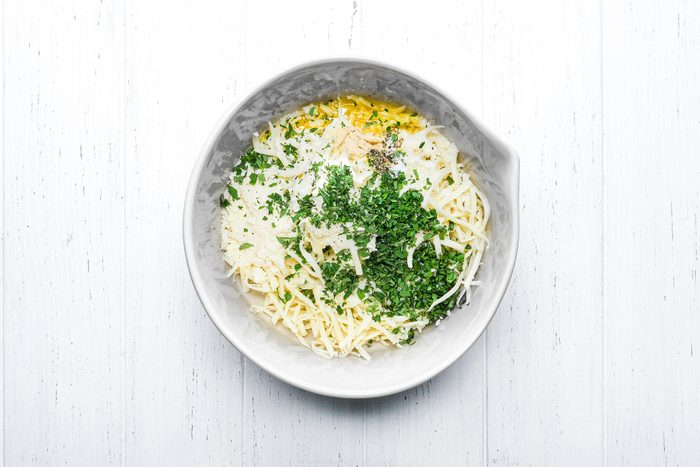
In a large bowl, combine the ricotta, mozzarella, Parmesan, egg, fresh herbs, garlic powder, salt and pepper, and stir until fully combined. Season to taste. Cover and refrigerate until ready to use.
Step 5: Roll out the dough
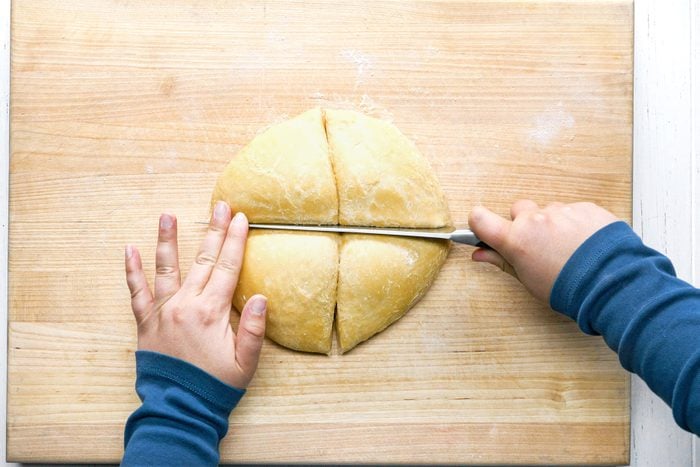
Divide the dough into four portions. Roll one piece to 1/16th-inch thickness, keeping the remaining dough covered until you’re ready to use it.
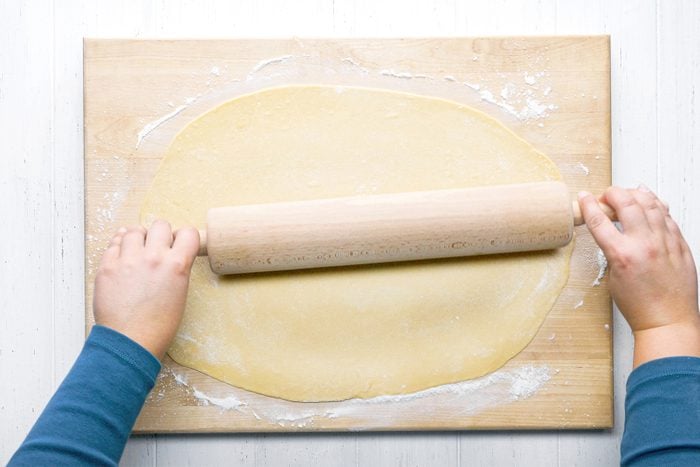
Editor’s Tip: If you choose to use a pasta rolling machine here, start by rolling your dough through the largest setting, folding it up like a letter, and putting it through the largest setting yet again. Repeat until you have a nice, uniform piece of dough as a starting point. Then, start working through the different settings on the machine to make the pasta thinner and thinner.
Step 6: Fill the ravioli
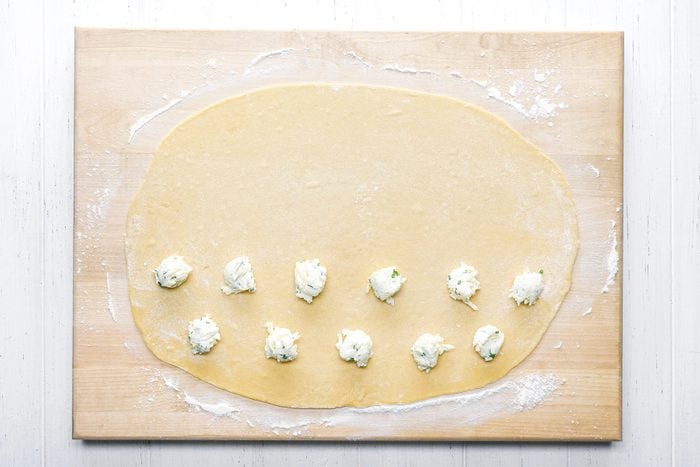
Working quickly, so as not to dry out the dough, place rounded teaspoons of filling 1 inch apart on half of the rolled dough, making sure that it’s not too close to the edge. Fold the sheet over, and press around the filling (not on it) to create a seal. Cut the ravioli into squares using a pastry wheel. Repeat the rolling, filling and cutting process with the remaining dough and filling.
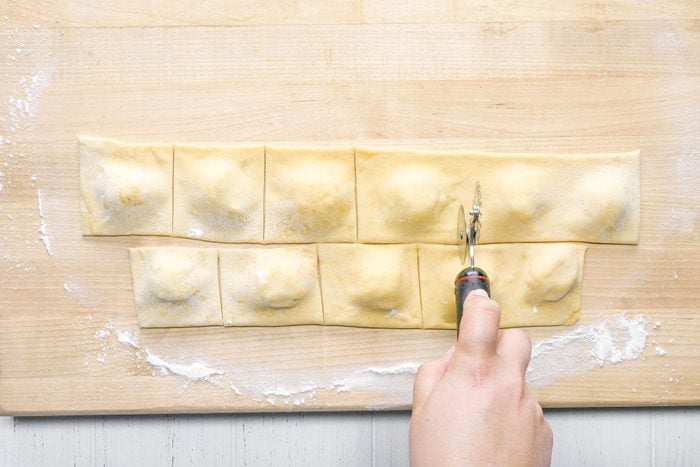
Editor’s Tip: I like to dampen my finger and run it between dollops of filling and down the edge of the dough to help the sheets stick together.
Step 7: Boil the ravioli
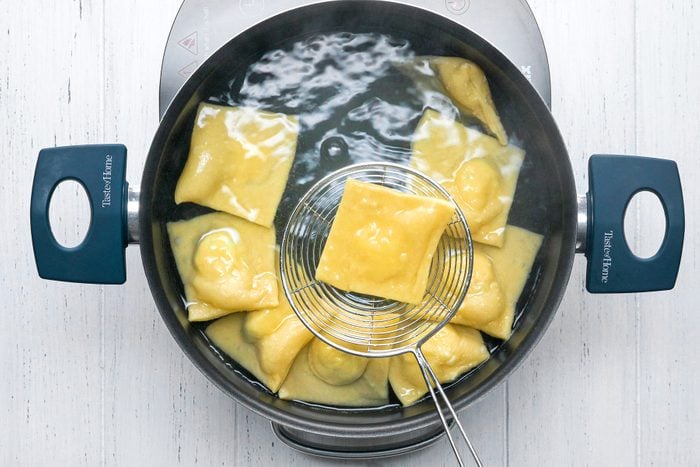
Bring a large pot of salted water to a boil. Add the ravioli, and reduce the temperature to achieve a gentle simmer. Cook the ravioli for one to two minutes, until they float to the top and become tender. When done cooking, drain the ravioli gently into a colander. Sauce and serve!
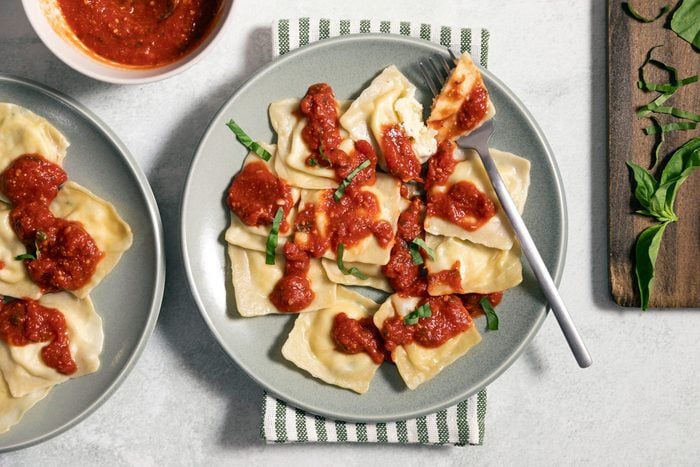
Editor’s Tip: Before dumping all of the ravioli in the pot, test just one raviolo. Sometimes, the place where the two layers of dough overlap takes a little longer to cook. You can adjust the time for the rest of your ravioli accordingly.
Ravioli Variations
- Add flavor and color to the dough: Try adding flavorful ingredients to your flour prior to mixing in the liquid ingredients. Things that are finely powdered, such as spices, can be a great choice. Some of my favorite pasta additions include smoked Spanish paprika, ras el hanout, powdered dried mushrooms, and powdered spinach, beet or tomato, which are available from most spice companies.
- Use a different oil in the dough: You can also add flavorful ingredients in place of some of the water, egg, or oil called for in the recipe. Or experiment with walnut oil or sesame oil in place of the olive oil, or swap in a vegetable puree like spinach.
- Experiment with sauces: Try a different type of pasta sauce, including things like sage and browned butter ravioli. Don’t have time for homemade sauce? Opt for the best jarred pasta sauce at the store.
- Fun with fillings: Leftover braised meats, mashed veggies, flavored goat cheese (like this tomato goat cheese spread)—there are so many possibilities for stuffing ravioli. Don’t be afraid to get creative. In Italy, they sometimes fill a large raviolo with a whole egg yolk!
- Tweak the size and shape: I’ve cut out ravioli with cookie cutters, the openings of mason jars and water glasses (be careful with glass!), and with specialized ravioli presses. Want a tomato-flavored octagonal pasta that looks like a stop sign? Go for it!
- Decorate the dough: TikTok and Instagram are teeming with people who make gorgeous, decorative homemade pasta dough. Get fancy with your own homemade dough with the help of many a pasta-making tool at your disposal.
Can you make ravioli ahead of time?
Yes, you can assemble the ravioli ahead of time (through Step 4), provided you cook and enjoy it later the same day. Once the ravioli is assembled, arrange it on a parchment-lined baking sheet dusted with a bit of flour. Store the freshly assembled ravioli at room temperature for up to one hour, or in the refrigerator for up to four hours. (Beyond that, the cheese will make the dough soggy, so consider freezing it for longer storage.)
Can you freeze ravioli?
Freezing ravioli is the best option if you’re assembling it ahead of time but don’t want to cook it on the same day. Arrange on a floured, parchment-lined baking sheet in a single layer, and freeze. Once frozen through, store the ravioli in freezer-safe bags or containers for up to one month. No need to thaw the ravioli before cooking it. When cooking frozen ravioli, just give it an extra couple of minutes, as it’s starting from a colder temperature.
How to Store Ravioli
If you haven’t yet cooked ravioli, it should be frozen, as noted above. Once ravioli is cooked, it can be stored in a tightly sealed container in the fridge for up to five days. If the ravioli is not sauced, toss it with a little bit of oil before storing so that the ravioli don’t stick to each other. If it’s already sauced, you’re all good!
Homemade Ravioli Tips
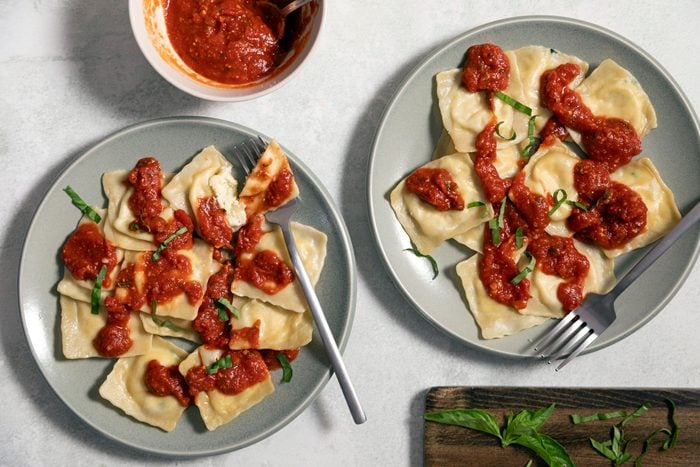
Do you put raw or cooked meat in ravioli?
Because ravioli cooks within minutes, it’s safest to use only cooked meat in your fillings, whether it’s ground beef, Italian sausage, ground pork or chicken.
How do you cut ravioli without a ravioli cutter?
To cut ravioli without a ravioli cutter, first lay one sheet of pasta dough on a floured surface. Evenly space out tablespoons of the filling on the sheet, and then lay another pasta sheet on top. Press the dough around each mound of filling to remove any air, then cut out squares with a pastry or pizza cutter wheel.
You can also use a chef’s knife, a cookie cutter or even a clean, food-safe box cutter! If your ravioli is well sealed, nearly any food-safe sharp object will do.
Do you need to boil ravioli?
If you’re using a sauce that is fairly liquid-y, you can skip the boiling step and simmer ravioli in the saucepan. You’ll want to cook the ravioli gently, and make sure that the sauce doesn’t burn on the bottom during the cooking process.
You could also parboil the ravioli, drain it, and finish it in the pot—this is something that restaurant chefs often do. Or bake your ravioli! Spoon a thin layer of sauce on the bottom of a baking pan, layer with uncooked ravioli and then spoon a little more sauce on top. Cover with foil and bake at 350° for 10 minutes, turning halfway through.
What can you do with pasta scraps?
If you cut ravioli into squares, you may not have any leftover dough, but if you cut it into circles, you will end up with some scraps. Tear up those scraps unevenly to make pasta called maltagliati, which means “badly cut” in Italian! Cook it for two to three minutes in salted boiling water, and you have a quick and easy vehicle for any extra sauce you’ve got in the house.
What do you serve with ravioli?
Salads and Italian side dishes are perfect accompaniments to ravioli. Think about your filling and your sauce, and choose dishes that mesh well with those flavors. Simple Parmesan roasted broccoli or garlic oregano zucchini would be perfect with many pasta dishes.

















